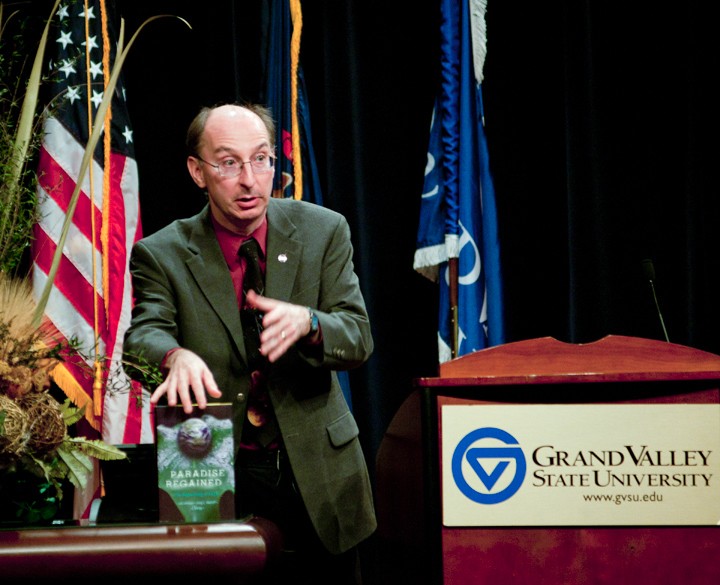Out of this world

Dr. Les Johnson speaking Monday during the How Space Development May Help Solve our Energy and Environmetal Problems lecture. The event was held in the Loosemore Auditorium.
Mar 3, 2011
In a presentation given by NASA scientist Les Johnson at Grand Valley State University’s Loosemore Auditorium Monday night, Johnson said he could survive for 1 minute, 41 seconds in the vacuum of space.
During his public lecture, Johnson focused on the involvement for protecting the planet and other possibilities for outer space.
“Tonight, I’m speaking as Les Johnson, private citizen and not as a direct representative of NASA, because I’m going to be telling you about what my vision for space exploration is and, in my opinion, what we ought to be doing,” he said
Johnson said as a planet, to stop the increase of carbon dioxide and other greenhouse gases, everyone would have to decrease their energy usage by a dramatic amount.
“We would all have to reduce our energy usage to roughly that of someone who lives in Kenya around the globe,” he said.
Johnson said things in space could benefit the entire planet. For example, the use of solar energy can reduce people’s reliance on fossil fuels and limit pollution. In one concept to harness solar energy, still in developmental stages, solar arrays in Earth’s atmosphere would collect energy and beam it down to the ground. Johnson said by putting a lot of the collectors in space, NASA could beam down energy usable to the public.
“The idea is that you can put square miles of collectors in space, collect the power and beam it down to the ground either with microwaves or lasers,” he said.
With recent advances in solar and laser technology and propulsion technology, Johnson said he thinks a space solar power station could be working in 20 to 25 years.
To help fight global warming, some projects are being developed to block some of the sun’s rays so the Earth does not heat as quickly. Unlike the solar power station, blocking parts of the sun could take 50 to 100 years to fully develop and implement.
Johnson said some of the sun’s energy can be blocked using solar sails.
“If you put enough of these big things between us and the sun and block just a teeny little tiny bit of the energy we get from the sun, you can completely offset the temperature rise that’s coming from the trapped greenhouse gases,” he said.
Besides fighting greenhouse gases and overpopulation, an idea is also in production to divert an asteroid if it were heading towards Earth. These concepts include using nuclear-powered spacecraft to push the larger asteroids out of Earth’s path, using smaller spacecraft to push smaller asteroids and using sunlight to push the asteroid out of the way.
In space, sunlight is powerful enough to push objects. On Earth, because of wind, gravity and other forces, sunlight is not powerful enough for us to feel its pressure. By using reflective surfaces to focus sunlight on an asteroid, the matter can be pushed so that it does not collide with Earth.
Physics Club president Kristie Barber said she enjoyed hearing about how everyone has the ability to work together throughout the course of Johnson’s lecture.
“This talk tonight really showed how the sciences and technology and engineers can all work together, which is something that our field is definitely pushing towards,” she said.
Johnson said people should try to help every living thing on the planet and be able to do it because it is the moral thing to do.
“Preserving the environment of Earth for life – all life, not just human life – is of vital importance and a moral thing to do,” Johnson said.

























